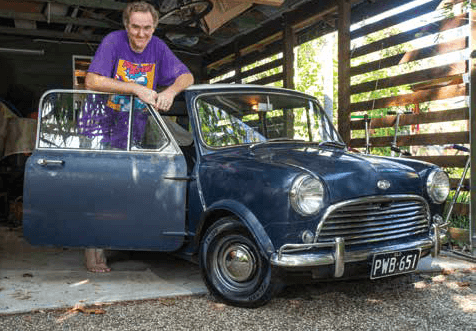Whether it’s your car or your heart that’s stopped, Anthony Miller’s amassed the skills to help in all emergencies.
People love you having a trade,” says Anthony Miller. “If you can use your hands, you can fix anything really.” The 45-year-old trained mechanic has put his skills to use across a range of machinery during his lifetime, but today, those skills have transferred to fixing even more important things. People.
Anthony made a career swap in his mid-30s, downing mechanic’s tools to retrain as a paramedic. Both jobs have brought their own challenges and rewards, but this father of four insists he would never have been driving ambulances or being emergency responder if not for his grounding as a mechanic.
“Fixing car problems is very satisfying, but there’s nothing like those couple of instances I’ve had where you literally save someone’s life,” he says. “That and delivering babies – bringing someone’s life into the world – it’s hard to beat really.”
Despite ten years since being a full-time mechanic, Anthony’s passion for vehicles remains, and when not driving ambulances or spending time with family, he’s to be found tinkering on his 1970 Morris Mini Cooper S MkII or 1943 Ford GPW Jeep.
Anthony bought and fixed up a Morris 1100 before he could drive, absorbing what he could from workshop manuals in an era before the internet. Showing natural aptitude for mechanics, he secured an apprenticeship at Brisbane BMW while still in Year 12.
“It was a great apprenticeship program there,” he remembers. “There were lots of us doing it, and with BMW’s own scheme we’d go twice a year to Sydney or Melbourne to do their training. We worked only on BMWs so knew them back to front, so it was always useful to do something with trade-ins too. Lots of sportscars were traded when people moved into family cars, so as an apprentice, we’d be working on used Porsches, Mercs and Ferraris.”
After nearly five years at BMW, and his apprenticeship complete, Anthony got the travelling bug. “I worked as a mechanic in the ski fields, then in the off-season went to work for BMW in Auckland, and at Coastline BMW on the Sunshine Coast,” he says. “When they find out you’re BMW trained, you tend to just turn up and they find a spot for you.”
Proving a mechanic’s trade opens many doors, while working the ski fields Anthony turned his hand to maintaining and fixing grooming machines, snowmobiles, trucks, buses, quad bikes, motorbikes and cars. “The main thing were snow groomers, which meant a good learning phase as I was now on heavy machinery,” Anthony says. “You’re in this big machine with hydrostatic drive and unlimited power for ploughing through the snow.”
Next move was Canada to a rental facility where he worked on lawnmowers, snow blowers, chainsaws and Bobcats, before heading to a fishing lodge to work on outboard motors and boats. “The principles remain the same no matter what you’re working on,” he says. “You just need to look at how things come apart and go back together again.”
When working at Perisher ski resort Anthony would spend evenings drinking with paramedics and was sold on their jobs. “In all the workshops I’d been, I rarely saw a happy old mechanic,” he says. “I never wanted to get like that, so didn’t want to be a mechanic forever. I didn’t want to be cleaning grease out of my hands, being cut and bruised and smashing my knuckles for the rest of my life.”
It took three years to retrain as a paramedic, and although he missed the variety and travel that came with being a roving mechanic, there were elements Anthony didn’t miss. “Sadly, no-one likes giving a mechanic money,” he explains. “You get a blown head gasket, pay $2500 and drive away a car that looks exactly the same but just runs well again. Being a paramedic’s the opposite. Everyone loves to see you walk through the door when someone’s sick or things are going wrong. Having someone call you a week later, thanking you for helping them stay alive, is pretty satisfying.”
With eight days on and six days off, free time is spent with his four daughters, plus a bit left over for the toys in the shed. His 1970 Mini Cooper S belonged to his late uncle, and had sat dormant in a South Australian shed for 40 years. “When he passed away I asked to have it, drove two days there, spent two days messing around with it then trailered in home,” he says.
“Despite not moving for 40 years there was no structural rust. I just cleaned the points up, changed the fuel, did the oil and filter then drove it straight onto a trailer. At home I pulled out all the thermostat housing, the water pump and flushed the engine continuously for a day to clear all the crap out. I cleaned the radiator, got the heater core re-cored, put new rubber hoses on, flushed the brake fluid and got a new exhaust and set of rims and tyres. I’ve been driving it since.”
It’s a true survivor car. The paint, although with surface rust blemishes, is totally original, as are the seats, carpets and bumpers.
“Some people want me to paint it, but I love the originality of it. It’s only original once.” His 1943 Jeep came out of Papua New
Guinea, and when he bought it in 1991 it even had World War II bullet holes in the body. That’s another project on the agenda, but typically, time, space and money hamper progress. “Every mechanic would love a big shed with a hoist, and I’m no different,” Anthony says. Despite his new career, the joy that comes from working on cars happily still remains.






